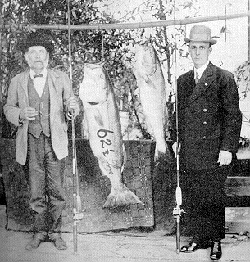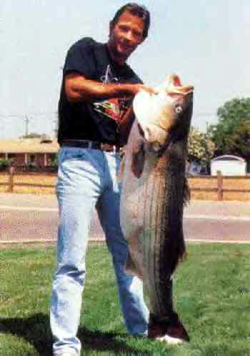-
 Original California striped bass came from Navesink River
Original California striped bass came from Navesink River
We were at the marina this weekend and someone told me this story so I decided to research it. Thought it was pretty neat.
California Striped Bass and Striped Bass Fishing
In 1879, 132 fingerling striped bass were introduced into the San Francisco Bay, after surviving a long train ride across the US from the Navesink River in NJ.
These did well, and an additional 300 fingerling made the same train ride three years later.
The fish prospered, as the San Francisco Bay is a large estuary incorporating an extensive delta which is formed where the Sacremento and San Joaquin rivers empty into the Bay.
By 1889 striped bass were being caught in sufficient numbers that a commercial fishery began. The commercial fishery was later determined to be detrimental to the maintenance of a strong recreational sport fishery. Commercial fishing was stopped in 1935 when the striped bass was declared to be a game fish.
 Early San Francisco Bay Stripers
Early San Francisco Bay Stripers
Most Pacific stripers spend summers feeding on anchovies in the ocean along the Pacific Coast. Many wander along the coast. Significant populations of striped bass have developed in Oregon; particularly in Coos Bay and the Umpaqua River.
Along the California Coast most stripers
re-enter the San Francisco Bay in fall and winter, and locate throughout the Bay and delta system. In spring the stripers head up the Sacremento and San Joaquin rivers to spawn. They travel as much as 124 miles upstream in the Sacremento River and also go into the Feather River.
In the delta region, the water is mildly salty where the river and bay waters mix. Striped bass linger there, adjusting to the difference in salinity before they transit up the rivers to spawn, and again when they return to the Bay.
Some stripers inhabit the San Francisco Bay area year round. Many stripers, however, head back to the Pacific Ocean after spawning.
 Hank Ferguson and his
Hank Ferguson and his
record freshwater striped bass
A major threat to maintaining a large striper population in the Bay area is the significant number of freshwater diversion projects in the rivers. Increasing amounts of freshwater are being diverted to agricultural projects and the California Aqueduct System. Besides reducing the amount of freshwater available for spawning, the pumps associated with these projects often suck up striper larvae and fingerling stripers.
Surprisingly, some stripers survive their diversion, and even prosper. The current California sport record striped bass is a 67½ pound fish, caught by Hank Ferguson in O'Neill Forebay on May 7, 1992. In fact, many freshwater lakes and impoundments in California that are fed by the aqueduct system now contain significant populations of striped bass.
http://www.striperspace.com/california_stripers.html
 Posting Permissions
Posting Permissions
- You may not post new threads
- You may not post replies
- You may not post attachments
- You may not edit your posts
-
Forum Rules
Early San Francisco Bay Stripers
Hank Ferguson and his



 Reply With Quote
Reply With Quote